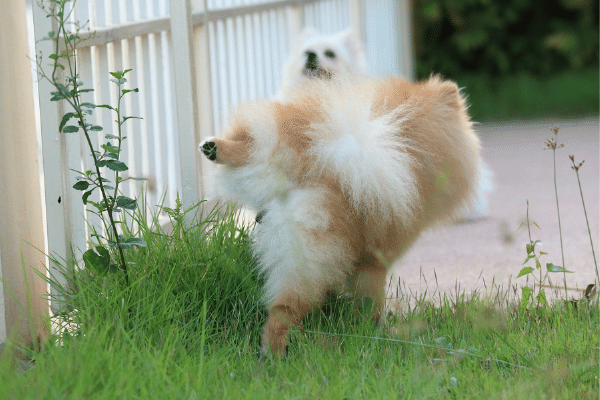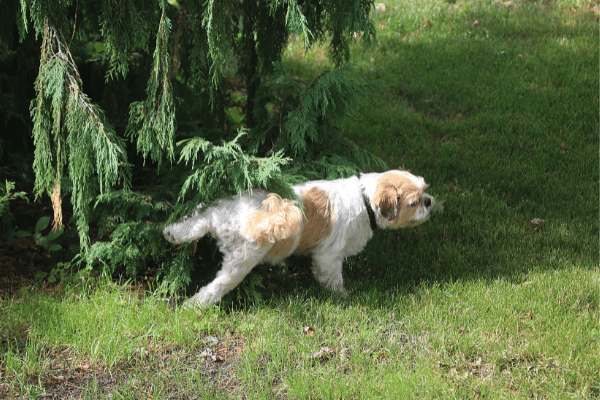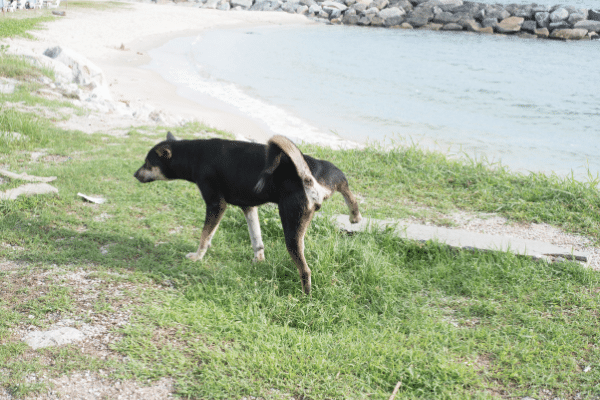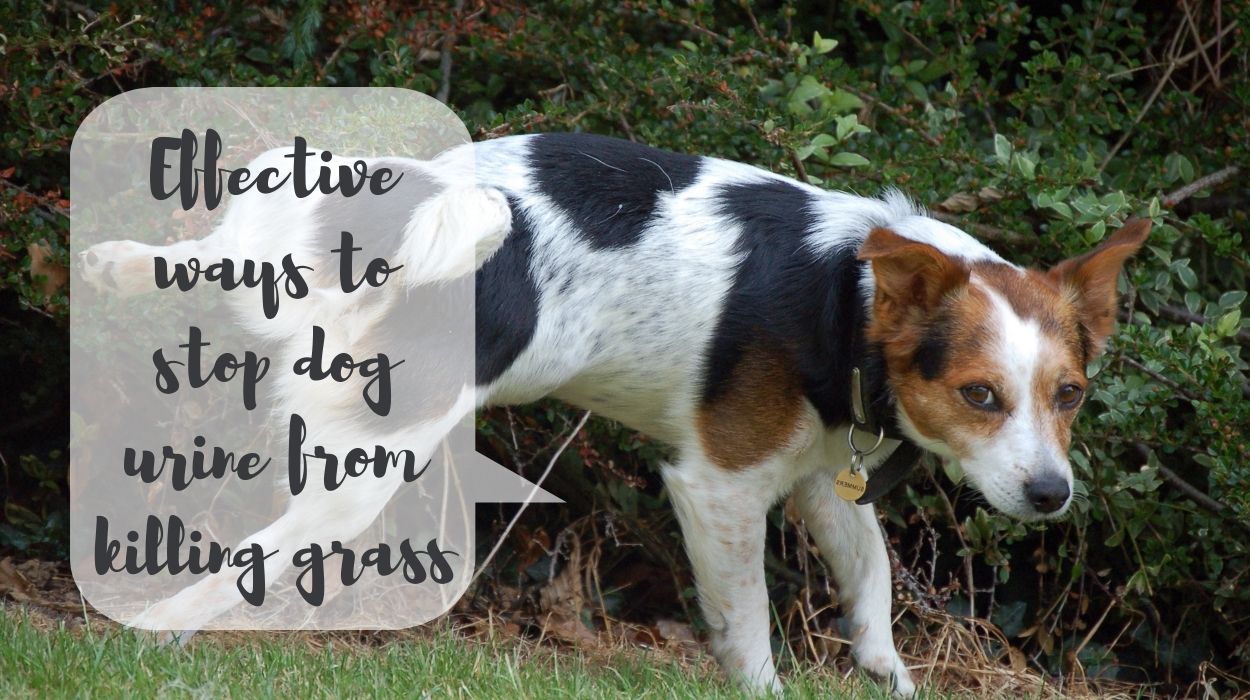Getting a dog is not that hard, but making him unlearn a few toilet habits is! Especially if you have a wonderful garden in the backyard, which has become an undesirable place with brown and yellow patches and a foul smell!
Are you curious to know the contents of a dog’s urine, that it can discolor the grass and kill them? Sick of those useless DIYs? Well, here we are to help you!
In this article, we have jotted down the most effective and proven ways to stop your dog from murdering your garden!
When dogs pee on grass, why does it kill it?

Nitrates! Yes, you heard it right; nitrates are the culprit that shamelessly kills the grass of your lawn!
The urine of your dog has a variety of nitrogen compounds. Your dog’s urine has a high amount of nitrogen because dogs are carnivorous, so they consume a diet that’s super-rich in protein, leading to high urine urea (nitrogen) levels.
If we talk in numbers, the percentage of nitrogen in a dog’s urine is 46%. So basically, you can compare the damage equal to a handful of burning fertilizer on your lawn! The grass is not just killed, but it is also stopped from producing.
The urine patches on your garden will usually occur when your dog decides to urinate at the same spot.
The more dilute urine is less toxic to grass!
Suggestion:
You must make sure about one thing: the damage to your grass is caused by dog urine, and there’s no one else involved in it! You should lift the grass or try grasping it to be sure of it. If the grass is attached to its root but only damaged from the upper part, then it’s the pee of your dog doing the damage, but if the roots came out loose, the culprit is someone else.
Does the gender or size of your dog matter when it comes to grass damage?

Well, yes, the gender of your dog does matter here because male dogs are more territorial and tend to urinate minor amounts in a variety of locations. While female dogs squat at a single spot, they are not that much into exploring different pee spots!
One may think that male dogs would be less of an issue than female dogs.
Smaller dogs that urinate less urine would be less of a problem. Also,
The degree of pee burn is determined by the number of solutes in the urine and how they relate to grass, urine volume, and lawn irrigation.
So basically, not the size of your dog, but the number of his pee matters!
The 7 best ways to prevent your dog from urinating on the grass

1. Epsom Salt
Salt appears to be a more effective and cost-efficient substitute for DL-methionine. Sprinkle some only on the affected area and then water it until you see the dead grass turning green!
The Epsom salt is a spot removal treatment.
2. Baking soda
Mix one gallon of water with two tablespoons of baking soda, pour it on the spots, and within a few days, see the results; this method is helpful to eliminate the smell firmly and works as a preventive measure. Dog tend to soil a particular area where they have their smell; if you catch your dog soiling that one area, you can use the baking soda solution on it so to make sure that no trace of your dog’s pee-poop is left behind.
Lawn burn would be a less serious issue for individuals who water their lawns frequently and choose a more resistant lawn grass species.
3. Frequently watering
Water is life, and you should take it seriously! The key is once your dog is done peeing on his favorite part of the grass, just take the water can and pour it on that particular area.
Apart from this, you should regularly water the grass, and pick such a time of the day when your dog is done doing his business.
Dogs and cats are very lazy when it comes to drinking water, which is why their urine is such a killer! You should help your dog in consuming his daily needs of water. The more his urine will be in dilute form, the less harmful it will be for your grass.
Look up a water calculator to ensure your dog gets enough water per day. A medium-sized dog should receive about 1 ounce per pound of body weight each day.
Five easy ways to encourage your dogs’ water intake:
- Ensure the bowl has been thoroughly washed and ensure the water is fresh every day. If that doesn’t work, try a different bowl.
- Try ceramic or stainless steel instead of plastic.
- Many dogs love to munch on a fresh ice cube chip or anything more solid than liquid; if you want to make it more interesting for your dogs, go for the easy-peasy DIY ice candy.
- Give your dog some chicken or beef Bouillon. It smells excellent, plus it’s full of nutritious values!
- You can add water to your dog food, kibble, canned, or even cooked food. You can soak the kibble in the water and then refrigerate it for 3 days!
4. Urine resistant grass
If you plan to build a garden in your backyard or have it already, go for Ryegrass and Fescue grass; they are the best for urine resistance. The grass can withstand cold, heat, drought, and shade and adapts to a wide range of climates.
You are mistaken if you think that urine-resistant grass will solve all your problems. They will buy you some time and will make your lawn resilient.
5. Teaching your dog to go potty in the right spot
For your dog to learn the potty spot training, he needs to be a good boy! So first, make sure that your dog follows all your commands.
Follow the easy steps:
- Pick a spot: most of the time, your dog tends to do this step for you; they usually love to soil a spot of their choice, so if you see them going to a particular spot, make it the one!
If they haven’t selected one, choose a spot that’s not near the roads or traffic.
It should be quiet—a big one for your big dog and a small spot for a smaller one.
- The area should always be kept clean: dogs do their business simultaneously, but not dirty! So pick up as soon as you can after your dog is doing his business.
- “Go” command: put a leash on your dog, take him on the spot, command him to go, and poop wait there until he’s done. Treat him, tap him, and say, “good boy.” continue with the treats for a while if he follows the same further.
6. Know where not to fertilize!
The nitrogen contained in your dog’s urine is already enough for killing the grass; you don’t need to add more fertilizer to it, as there’s nitrogen in it.
So basically, you fertilize your garden, and your dog comes and urinates on it, so even a small amount of urine can be harmful.
If you already see brown or yellow patches on the field, just skip the area and fertilize the rest of it.
7. Use a dog rock!
In addition to saving your grass from burn marks, the dog rocks are a natural and safe solution that helps prevent your grass from getting burned by dogs’ urine. These dog rocks are easy to use; you just put them in your dog’s water bowl.
When your dog drinks water from this bowl with dog rocks, the amount of nitrate from the water will decrease, and eventually, your dog will consume water that has less amount of nitrate.
Do you have concerns about your dog’s safety when using these products? We would like to tell you that they have been used for 18 years from now across 35 countries. These products will not change the pH balance of urine or water.
No side effects have been reported after the dog rocks were tested on millions of dogs! For best results, you have to replace it every 2 months.
It takes approximately five weeks for the dog rocks to work; they impact water after 8-10 hours. Lawn burns will fade over time.
Before using the dog rocks, keep the following points in mind:
- Before using the rocks, make sure you wash them with water.
- For every 2 liters of water, 1 bag of dog rocks is enough. Before using the dog rocks, keep the following points in mind:
- Since it takes a good 6-8 hours after sitting in the water, it’s best to add these rocks to the water bowl before going to bed at night.
- After two months, the effect of dog rocks minimizes to almost zero.
8. Keep track of In-Season Female Dogs
It’s no hidden fact that female dogs in heat can cause more damage to your grass than they do on regular days; it’s because her urine is more toxic during this phase. The best thing you can do for your dog is taking her for a pee-poop walk whenever her body language indicates that she needs to go!
If your dog still manages to pee in the garden, water that area immediately.
9. Your dog needs a balanced diet
Dogs are obligated carnivorous, so meat makes up most of their diet. Many experts would recommend that you balance your dog’s diet with some human food!
But without complete knowledge, you should not mess with the dog’s diet; the high meat contained means high protein, and high protein leads to urine high in nitrogen.
To be on the safer side, you should consider adding fruits and vegetables to your pooch’s diet. Remember that it’s impossible to see the visible differences in one feeding, but you need to maintain consistency.
The idea would be to feed your dog the fruit and vegetable diet three times a week.
Fruits and vegetables to include in your dog’s diet:
| fruits | Vegetables |
| watermelon | pumpkin |
| apples | kale |
| Raspberries | Sweet potato |
| pears | zucchini |
| Bananas | peas |
| Pineapple | cucumber |
| Peeled oranges | celery |
10. Litter box
Sometimes dogs are too intelligent to understand that we are trying to stop them from doing a particular thing but too shallow to understand why! Try installing a litter box outside for dog parents with babies that make every trick ineffective.
By doing this, you can have so less to worry about as your dog will go to his spot to pee or poop and find his litter box there; he will understand what next has to be done.
If you are yet to litter train your dog, it might be pretty tricky for you to hold a considerable amount of patience in making him learn, but it’s worth it as you will have a cleaner and odorless garden.
Some common myths vs. reality!
We appreciate the love for popular DIYs and home remedies, but before falling for them, you should inspect a few moments in the depth. After all, you should not believe everything that’s on the internet.
#myth number1 baking soda neutralizes dog urine on grass
Reality: once the grass turns yellow due to the dog’s urine, there’s no coming back; nothing can make a grass greener if it has turned yellow due to the damage. You might end up damaging it more.
#myth number2 tomato juice will stop dog’s pee from killing grass
Reality: no, it is not valid! Tomato juice can’t stop your dog’s pee from killing the grass, as it does not have the ability to change the nitrogen levels in dog urine.
#myth number 3 only female dogs leave urine spots
Reality: it would be so unfair on our female dogs to say that! The spotting has only one root cause, and that’s nitrogen. The more nitrogen you pour on the grass, the more damage it will face. So it’s a matter of quantity!
#myth number 4 using more fertilizer on the spots is helpful to get rid of the yellow-brown spots
Reality: no! Dog urine and nitrogen fertilizer are incompatible. Your dog is essentially fertilizing your yard with nitrogen fertilizer. When you use commercial fertilizers, you’re adding nitrogen to the mix, making the pee spots worse. Adding extra fertilizer to a lawn harmed by dog urine is usually more harmful than beneficial.
Final word
Yes! Owning a dog and having a beautiful lawn are both possible only if you are willing to do some work! One thing that’s familiar with both the grass and your pet dog is that they require time and patience to work miracles!
Whatever you plan to do, just stay away from pills that alter the pH balance of your dog’s urine; it can result in UTI, bladder infection, bladder stones, and other digestive issues. Even vets suggest you not go for them, after all noting that it is more precious than your canine’s health.

Dr. Aram Baker has been with Santa Clarita Animal Hospital since 1995 and his special interests include behaviour medicine and dermatology. He graduated from the Cleveland Humanities Magnet Program in Reseda, CA and attended California State University at Northridge where he received a Bachelor’s degree in biology. He went on to pursue his Doctorate in Veterinary Medicine at the University of California at Davis. He also spent time in the zoological medicine department at U.C. Davis during his Junior and Senior years. He is dedicated to caring for all pets big or small, young or old with compassion, patience, kindness, and love.
